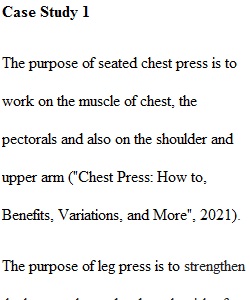


Q select one of the case studies below for use in this assignment. Case Study #1: Jolene is a 34-year-old woman who weighs 137 pounds. Jolene is 65 inches tall, healthy, and does not have any known medical issues. Her one-repetition maximum (1RM) for each of the following exercises is as follows: Seated Chest Press: 70 lbs. Leg Press: 120 lbs. Curl-ups (1 minute): 19 Modified push-ups (1 minute): 24 Case Study #2: Julio is a 49-year-old man who weighs 220 pounds. Julio is 76 inches tall, healthy, and does not have any known medical issues. His one-repetition maximum (1RM) for each of the following exercises is as follows: Seated Chest Press: 180 lbs. Leg press: 340 lbs. Curl-ups (1 minute): 24 Once you have selected a case study, complete the following steps: • First, thoroughly examine the assessments used to obtain the provided results for your client by addressing the following: o What is the purpose of each of the assessments? o What are the benefits of performing multiple assessments? o Compare each of the assessments to one another. What is different and/or similar between them? • Next, assess the muscular strength and endurance status of your client by addressing the following: o Calculate your client’s strength and endurance using Laboratory Assessments 4-1 and 4-4. o Explain the results to your client (from your selected case study). Use your client’s name and write as if you were speaking directly to her/him. • Then, develop an effective resistance-training exercise plan by addressing the following: o Complete the “Exercise Chart Download Exercise Chart” for your client. ? Select eight exercises that will enhance your client’s muscular fitness. ? Illustrate the intensity and duration by indicating the numbers for the set(s), reps, and weight that will be required. ? Designate a frequency by indicating the dates that each session should occur. ? Demonstrate your understanding of progressive overload. This can be designated in the plan through writing a detailed statement in the “Notes” section of the log. • Next, explain the assessment results and exercise plan to your client (from your selected case study). Use your client’s name and act as if you were speaking directly to him or her. After explaining the results of the assessments, provide your rationale for each component of the plan: exercises, intensity, duration, frequency, and progressive overload. • Lastly, assess two factors that can impact your client’s muscular strength (e.g., gender, diet, hormones, muscle size, muscle mass, and muscle fiber recruitment). Explain these factors to your client. • Submit your assignment for grading using the Assignment Submission Button.
View Related Questions